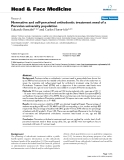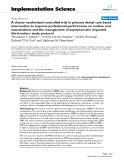
HUE JOURNAL OF MEDICINE AND PHARMACY ISSN 3030-4318; eISSN: 3030-4326HUE JOURNAL OF MEDICINE AND PHARMACY ISSN 3030-4318; eISSN: 3030-4326
14 15
Hue Journal of Medicine and Pharmacy, Volume 15, No.2/2025 Hue Journal of Medicine and Pharmacy, Volume 15, No.2/2025
Oral health-related knowledge, attitudes, and behaviors of students
wearing fixed orthodontic appliances at Hue University of Medicine
and Pharmacy
Nguyen Ngoc Tam Dan1, Nguyen Gia Kieu Ngan1, Nguyen Le Minh Trang1, Tran Thien Man1, Hoang Anh Dao1*
(1) Faculty of Dentistry, University of Medicine and Pharmacy, Hue University
Abstract
Background: Oral hygiene is vital to each person’s oral health, especially in those undergoing orthodontic
treatment. However, only some people know how to properly and effectively clean their teeth. Therefore,
assessing oral hygiene knowledge, attitudes, and behaviors is necessary. Objectives: To determine the level
of knowledge, attitudes, and behaviors of oral hygiene of students wearing fixed orthodontic appliances
and to examine the relationship between knowledge, attitude, behavior of oral hygiene, and plaque status
in students who are wearing fixed orthodontic appliances. Subjects and methods: A cross-sectional study
was carried out on 80 The Hue University of Medicine and Pharmacy students wearing fixed orthodontic
appliances. The study was conducted from 06/2023 to 09/2023. Results: 82.35% of students have adequate
oral hygiene knowledge, 68.63% have a positive attitude, and 63.73% have proper behavior. The average
plaque index on teeth is 0.988 ± 0.412, and our study found only a moderate positive association between
plaque status and oral hygiene knowledge (r=0.307, p=0.005). Conclusion: Knowledge, attitude, and oral
hygiene behavior are important factors that directly affect the effectiveness of the orthodontic process.
Therefore, it is necessary to promote the provision of adequate oral hygiene knowledge, positive attitudes,
and proper behaviors to improve the oral health of healthcare students - who have an impact on their health
community in the future.
Keywords: knowledge, attitude, behavior, oral hygiene, plaque, fixed orthodontic.
1. INTRODUCTION
Oral health is essential to an individual’s overall
health and is related to knowledge and healthy
oral hygiene habits. The World Health Organization
defines oral health as one of the ten major health
standards. Therefore, the care and prevention of oral
diseases are significant concerns of the governments
of many countries [1].
There are many ways to achieve good oral
hygiene; many techniques have been shown to have
a good impact on oral hygiene. One of the primary
behaviors is brushing teeth [2]. Brushing your
tongue, using mouthwash, brushing, and flossing
will also help promote oral hygiene [3]. However,
even with knowledge, without proper attitudes and
practices, oral hygiene practices may not meet the
requirements. Therefore, dental care is indispensable
in human health care, especially in people undergoing
orthodontic treatment with fixed appliances. Because
the attachment of fixed appliances to the teeth will
form a large amount of plaque around the brackets,
along the gingival margin beneath the archwire, due
to difficulties in oral hygiene, especially in the areas
between the brackets and the gum line. Orthodontic
appliances contribute to environmental changes,
accumulating many acid-producing bacteria in dental
plaque [4]. In addition, medical students are the
object of better access and awareness about oral
health care issues - trained to become doctors with
a heart and a vision, cultivating knowledge, good oral
health attitudes and behaviors, and preventing oral
diseases play an essential role.
According to a study by Nada J Farsi (2020),
knowledge of periodontal health in orthodontic
patients related to dental plaque still needs
improvement; only 8% correctly answered
knowledge-related questions [5]. At Hanoi Medical
University (2021), 12.8% of Odonto-Stomatology
students had inadequate knowledge, and 11.2%
had improper behavior in oral hygiene [6]. Studies
on oral hygiene knowledge in students wearing
fixed orthodontics still need to be conducted more.
Therefore, we carried out the topic: “Oral health-
related knowledge, attitudes, and behaviors of
students wearing fixed orthodontic appliances at
Hue University of Medicine and Pharmacy”
Objectives of the study:
- To assess the level of knowledge, attitude, and
Corresponding Author: Hoang Anh Dao, email: hadao@huemed-univ.edu.vn
Received: 7/11/2024; Accepted: 10/3/2025; Published: 28/4/2025
DOI: 10.34071/jmp.2025.2.1











